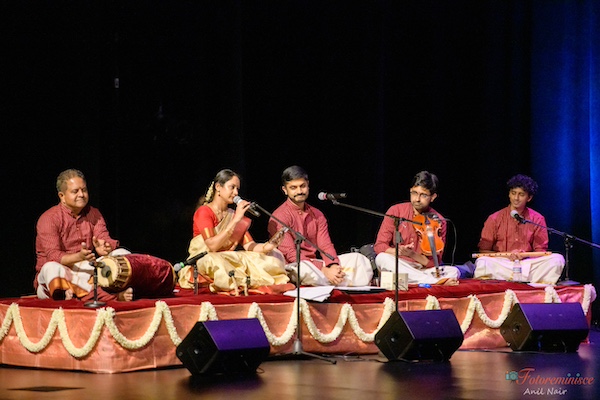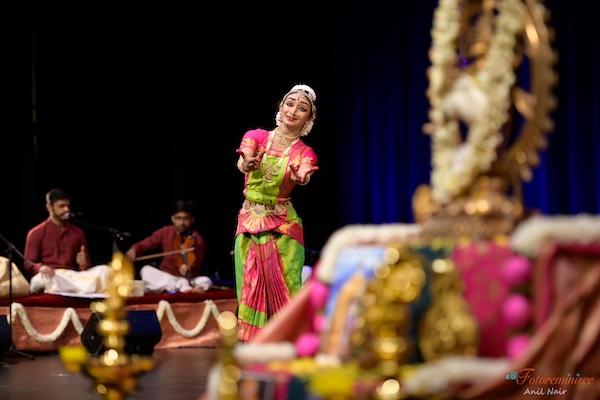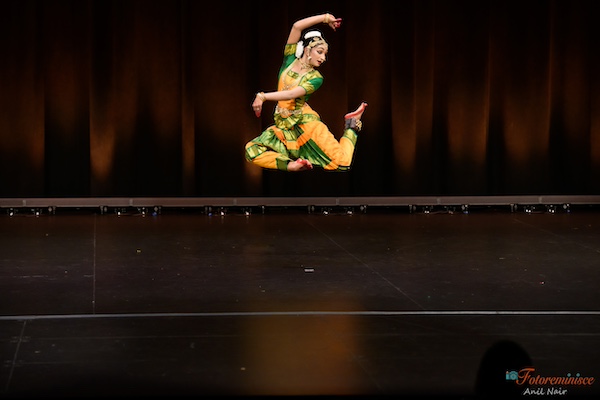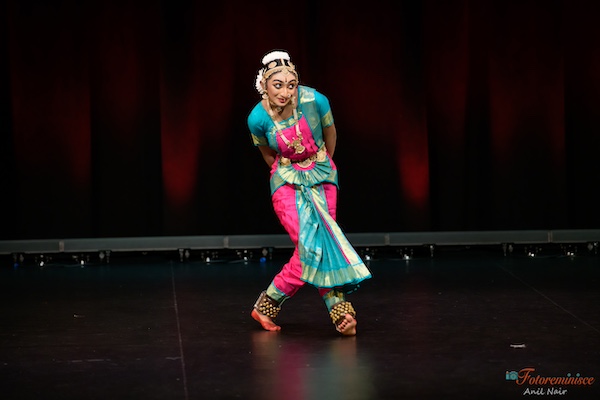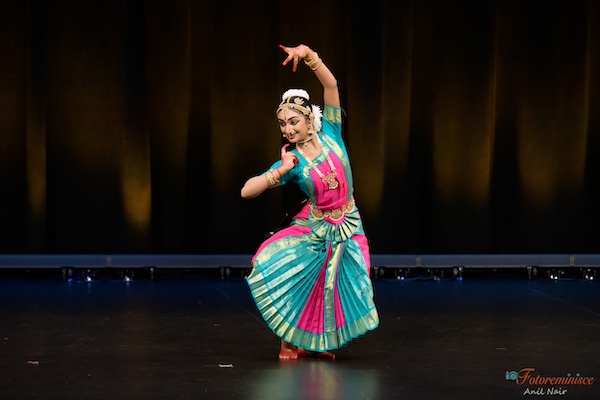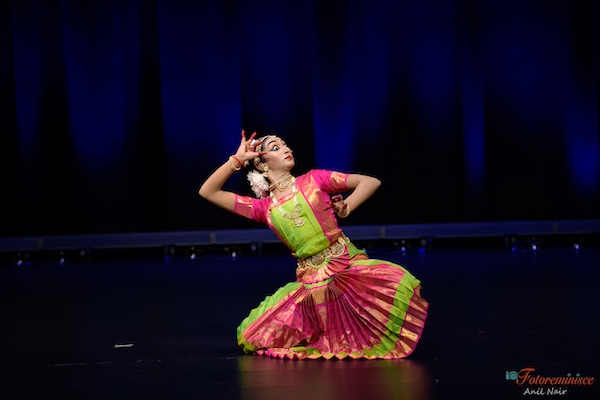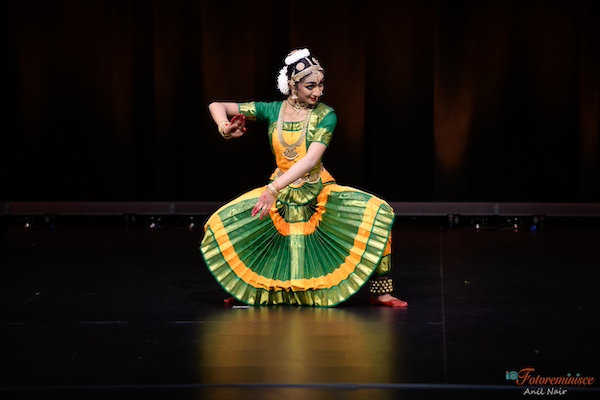Contribute
| Arangetram: Vaishnavi Pillai |
Amrutha Ananth
10/11/2025
Dancing the Divine: A Kaleidoscope of Rasas and Personas in Vaishnavi Pillai’s Arangetram Written by Amrutha Ananth An arangetram is never just a debut; it is a dialogue between dancer and deity, between body and bhava, between rhythm and rasa. For Vaishnavi Pillai, this evening was not merely about stamina or memory, but about the courage to embody gods in their many moods. Across the performance, she moved fluidly from Krishna’s impish leelas to Hanuman’s loyal strength, from Shiva’s compassionate majesty to the goddess’s quiet radiance, before circling back to Krishna as the cosmic protector. The orchestra set the tone with the invocatory “Jaya Jaya Swamin” in Ragam Naatai and Adi Talam — a composition extolling Lord Ganapathi in his many forms: nourisher of deities, remover of obstacles, companion of Skanda. The interplay of melody and rhythm mirrored Ganapathi’s multi-faceted persona, preparing the audience for the kaleidoscope of divine embodiments that were to follow. It was a subtle but powerful signal that this was not going to be a linear recital, but a gallery of moods — each deity embodying a rasa, each composition flowing into the next like beads on a single garland. The Playful Charm of Krishna Muralidhara Kauthuvam – Ragam: Arabhi, Talam: Adi, Composer: Sri Madurai R. Muralidharan The evening’s first major piece unfolded in Arabhi, a raga that sparkles with brightness and auspiciousness. In Muralidhara Kauthuvam, Vaishnavi embodied Krishna in his many avatars: the cowherd, the beloved of the gopis, the butter thief, the vanquisher of Kalinga, the boon-giver. From the outset, the first sollukattu— “thath dith dhrigunakka dhrigunakka jam jam” — demanded attention. The choreography cleverly paired the rhythm with the sahitya “ayar kulathinil aanirai meithavan” (the one who tends the cows of the Yadava clan). Here, Vaishnavi’s footwork was crisp, her movements measured, her expression inviting — Krishna was not distant but intimate, a boy next door with divine charm. The second sollukattu showcased striking contrasts in tempo. The alternating speeds, dominated by tripataka hasta, mirrored the lyrical idea of Krishna as Varada Azhaga — the one who grants boons. In these shifts, Vaishnavi balanced stillness with bursts of dynamism, hinting at the duality of Krishna as playful child and compassionate protector. A particularly delightful moment came when choreography wove the image of Krishna splashing in water into the jathi, perfectly matched with the sahitya “kamala malar mukha”. The visual association between the lotus-face and rippling waters was choreographic brilliance, and Vaishnavi executed it with grace. Later, as the sahitya moved into Krishna herding cows (“janakum janam thari”), Vaishnavi embodied the shepherd with pastoral charm, before transitioning seamlessly into “mayavane madhusudane” — Krishna the cosmic trickster, slayer of demons. Her abhinaya sparkled in fleeting moments: Krishna’s mischievous delight in stealing butter, his youthful play by the waters of Yamuna, the pastoral ease of a cowherd tending his herd, and the victorious stance of the serpent-slayer Kalinga. Each shade was distinct yet fluid, reminding us that Krishna is never bound by one identity. Each persona carried shades of śṛṅgāra rasa, not just as romantic allure but as playful intimacy. Even the pauses in her jathis became invitations — silences where the audience leaned into Krishna’s leela. Pure Dance as Architecture Jathiswaram - Ragam Hamsanandhi, Talam Rupakam, Composer: Sri. K.N. Dandayudhapani Pillai Where the Kauthuvam bathed the stage in Krishna’s charm, the Jathiswaram shifted the focus to structure and form. Set in Hamsanandhi and Rupaka talam, this composition by Dandayudhapani Pillai reminded the audience that Bharatanatyam is not only storytelling but also architecture in motion. Here, melody and rhythm converse without explicit narrative, demanding the dancer hold the stage with sheer geometry, precision, and stamina. Vaishnavi rose to the challenge. The opening adavus unfurled like temple gopuram designs — sharp diagonals giving way to sweeping arcs. Each araimandi held its depth, each mudra landed with clarity. Her torso lent tautness, making transitions crisp, yet her lines breathed with musicality. The final swaram was a revelation. While Jathiswarams are typically celebrated for abstract nritta, here a subtle persona shimmered through. In the gentle sways of her upper body, the deliberate use of strimukham hastas, and the brief gesture of hands poised on shoulders while executing an adavu, one could glimpse the suggestion of feminine energy — a quiet evocation of śakti. It wasn’t literal abhinaya, but the kind of suggestion that lingers in the mind’s eye, offering a glimpse of the dancer’s interpretive imagination. In this way, the Jathiswaram acted as a bridge — moving us from the persona-driven Kauthuvam into deeper emotional landscapes, and reminding us that even in pure dance, rasa resides quietly beneath the surface. Valor and Devotion in Hanuman Krishna’s allure was in playfulness; Hanuman’s, in paradox — fierce yet humble, mighty yet surrendered. The Shabdam “Vayu Maindhane”, a gem not often seen, highlighted this duality. The ragamalika structure mirrored Hanuman’s multi-faceted persona. Each raga change became a new shade: the warrior leaping into battle, the humble servant bowing before Rama, the compassionate protector assuring Sita. The Misra Chapu talam, with its lilting, unpredictable pulse, embodied Hanuman’s boundless, almost uncontainable energy. Vaishnavi’s interpretation was stunning in its balance. In “vaanara veerane”, she carved out leaps that crackled with vīra rasa, her torso lifted high, chest expansive, movements larger-than-life. Yet when the lines softened into “marutiye”, her body language shifted: palms folded, eyes lowered, revealing Hanuman the bhakta, whose strength is nothing without surrender. A highlight came in “Rama namam solli aalkadal thandiya,” where Hanuman crosses the ocean chanting Rama’s name. As the orchestra repeated the syllables “Ram, Ram, Ram” in rising intensity, the sound itself became the oceanic current that carried Hanuman forward. Vaishnavi responded with bold strides that seemed to stretch across space itself, punctuated by moments where she literally seemed to grow in size — arms widening, chest expanding, energy magnifying. The synergy of sound and movement culminated in a breathtaking portrayal of Hanuman soaring across the sky, cradling the Sanjeevani mountain — a vision of might rooted in service. For a Shabdam, which often leans heavily on narrative and less on virtuosity, this choreography brimmed with both scope and intensity. Vaishnavi excelled — her nritta sharp, her abhinaya layered, her stage presence magnetic. It was as though she invited us to see not just Hanuman the monkey-god, but Hanuman the bridge between power and humility. The intermission itself was no pause but a continuation of the evening’s narrative thread. The orchestra offered a Krishna medley, beginning with the lilting pallavi “Alaipayuthey Kanna”, moving seamlessly to the anupallavi “Panaga Shayana Parama Dayakara” from Enna Solli Azhaithal, and concluding with “Paatitha Suraripu Paadha Brinda” from Govardhana Giridhara. In those few minutes, Krishna’s many personas unfolded yet again: the tender beloved who responds to a devotee’s call, the supreme protector resting on Adisesha, and the fearless Govardhana-lifter shielding his people. Each phrase of music painted a rasa — śṛṅgāra in the yearning of Alaipayuthey, karuṇa in the compassion of Parama Dayakara, and vīra in the triumphant stride of Govardhana Giridhara. It was an apt interlude, reminding the audience that Krishna is never bound to one role — he is lover, lord, and guardian all at once. The medley set the perfect bridge to the second half of the recital, deepening the kaleidoscope of divine personas Vaishnavi was unfolding through dance. Longing and Surrender to Shiva The varnam, Swami Naan Undan Adimai, formed the recital’s heart. Here, Vaishnavi transformed into the devotee whose yearning for Shiva wavered between passion and surrender. The śṛṅgāra rasa of longing mingled seamlessly with the śānta rasa of devotion. Her abhinaya revealed vulnerability: eyes searching for Shiva’s distant presence, hands sketching the crescent moon in his locks, the body arching as if pulled by equal weights of desire and devotion. The sanchari sequence that depicted Shiva as Neelakanta — drinking the poison from the ocean’s churning — was particularly brilliant. But the true marvel came in the second jathi. Constructed with ingenuity, one side was danced entirely as Shiva, the other with the subtle nuances of Parvati, bringing alive the image of Ardhanarishvara. The transition into “maathor panga” after this jathi felt both natural and delightful, amplifying the theme of duality. Vaishnavi’s ability to embody the masculine and feminine energies with such apt body language was nothing short of commendable. Another highlight came in the change of nadai for “natanam aadi sevadi darishanam endru,” a visual delight that kept the audience spellbound. For the lines “Nataraja Deva,” the intricate kanakku would have been a particular treat to any rhythm-savvy rasika! Personas surfaced again in the lines “punnagai thavazh idhazhin,” where playfulness and tenderness intertwined before dissolving into the grand finale: Vaishnavi striking the pose of the cosmic dancer, Nataraja, as the refrain of “Nataraja” echoed in the background. Her nritta passages were no less compelling. The adavus in the jathis carried stamina and clarity, yet never overshadowed the emotional arc. Each rhythmic sequence felt like a plea, a prayer repeated until heard. Tender Radiance of the Goddess The varnam unveiled grandeur, while the padam turned inward. In Chinanjiru Pen Pole, Ulundurpettai Shanmughasundaram envisioned the goddess as a little girl — delicate, radiant, and quietly powerful. Vaishnavi’s abhinaya captured this beautifully. I especially loved the many ways she interpreted the pallavi line, “chinanjiru penn pole sitradai idai uduthi”—each repetition carried a different shade, from playful innocence to luminous dignity. Her sanchari was equally evocative: eyes compared to darting fish, bees buzzing over a flower, the fleetness of a deer. Each metaphor was etched with clarity, bringing alive the verse “penn avalin kann azhagu”. One of the most striking choreographic touches lay in the way Acharya Aishwarya had framed this piece. At the beginning, Vaishnavi sat in stillness with her back turned to the audience, as if to withhold the image of the goddess. Through the unfolding of the padam, we witnessed glimpses of the goddess—the smile, the glance, the sway—until finally the full form of Durga was revealed in a closing pose, seated and facing the audience. The narrative arc (opening to closing) felt intentional: a journey from mystery to revelation, curiosity to recognition. Sindhubhairavi, with its supple and emotive quality, gave her room to shade emotions with delicacy. Vaishnavi’s gestures suggested nurture in one moment, quiet defiance in the next, and a radiance that lingered throughout. This was not the goddess enthroned on a pedestal, but the goddess as every woman—tender yet resilient, childlike yet powerful. Innocence in Friendship with Krishna Traditionally a śṛṅgāra padam, Indina Dhuna Sakhi was reimagined through friendship — tender, playful, touched with the insecurities of childhood bonds. A young girl wonders: “Why does Krishna no longer look at me? We were just playing — what mistake did I commit?” Vaishnavi painted this premise with clarity, her abhinaya balancing maturity of interpretation with a subtle childlike sparkle. Alternating seamlessly between the persona of the girl and that of Krishna, she gave us a dialogue of two presences — the confiding voice of the girl and the silent, elusive figure of Krishna. Particularly charming were the passages where she called out to Krishna to join her in play, her eyes lighting up with innocent hope. The choreography by Acharya Aishwarya deserves special note. Each sanchari vignette was finely etched, showing not only companionship but the texture of shared childhood: the playful turns at pallanguzhi, the tossing of a ball, the pelting of a stone at a tree to pluck fruit. The most poignant image came when the girl, in recalling those moments, remembered keeping the juicier piece of fruit for herself — a gesture so ordinary, yet in her child’s imagination, perhaps the mistake that estranged Krishna. As Vaishnavi enacted the line “endha aparadam cheiden,” the audience felt the sting of her self-questioning, as though the smallest lapse in friendship had grown into an unbearable absence. What made the performance resonant was its duality: the “then and now.” On one hand, a luminous recall of shared play; on the other, the present ache of distance. By alternating between these states, Vaishnavi elevated the padam beyond nostalgia into a meditation on the fragility of bonds — how even in the most innocent of friendships, longing can slip in. Here, Krishna was not the eternal lover or the cosmic lord, but the childhood friend — approachable, yet just out of reach. The rasa that emerged was a gentle shade of vātsalya and karuṇa, making this padam a quiet highlight of the evening. The Cosmic Protector The evening drew to a jubilant close with Swathi Thirunal’s Dhanashree Thillana, a sparkling finale that married rhythmic brilliance with lyrical devotion. The interplay between nattuvangam and mridangam in the “geetha dhwanikku” passages — especially the spirited korappu at the end of the jathi — set the stage for Vaishnavi’s exuberant footwork and expansive lines. When the refrain “Padmanabha tumhari leela” rang out, it encapsulated not just the thillana but the spirit of the entire recital: the divine play in all its facets. Here, Krishna was no longer the cowherd of the Kauthuvam or the childhood friend of the Padam; he emerged as Padmanabha, the eternal protector, his leelas vast and infinite. Vaishnavi’s controlled spins, soaring leaps, and luminous concluding poses radiated ānanda rasa — joy that was both personal and universal, reminding us of the sheer bliss of surrendering to dance and devotion alike. In that final vision, Krishna’s many guises across the recital — playful child, shepherd, companion, and divine guardian — converged into one seamless persona. It was as though the kaleidoscope of rasas we had witnessed throughout the evening had clicked into place, revealing the wholeness of the divine. Rasas as Mirrors of the Divine By the end, the audience had not only witnessed Vaishnavi Pillai’s debut but had walked through a gallery of divine personas. Krishna’s mischief (śṛṅgāra), Hanuman’s loyalty (vīra and bhakti), Shiva’s compassion (śānta), the goddess’s quiet radiance (karuṇa), and Krishna’s cosmic joy (ānanda) — each was distinct, yet stitched together seamlessly by her conviction. With such a richly textured orchestra — Aditya Venkatesh (vocals), Acharya Aishwarya Balasubramanian (nattuvangam), Pranav Swaroop (violin), Skanda Prasad Rao (flute), and Murali Balachander (mridangam) — the recital became a complete experience, where music and movement flowed as one What made the recital resonate was this: in showing us gods in their many moods, Vaishnavi also mirrored our own lives. After all, don’t we all oscillate between playfulness, loyalty, longing, tenderness, and joy? Through dance, the divine became human, and the human divine. In doing so, Vaishnavi carried both the weight of tradition and the grace of devotion with remarkable poise, leaving the audience with a debut that felt both timeless and deeply personal.
Shabdam: Vayu Maindhane, Ragamalika, Misra Chapu, Composer: P.R. Venkatasubramaniam
Interlude – Krishna Medley
Varnam: Swami Naan Undan Adimai, Ragam Nattakurinji, Talam Adi, Composer: Sri Papanasam Sivan
Padam: Chinanjiru Pen Pole, Ragam Sindhubhairavi, Adi Talam, Composer: Sri Ulundurpettai Shanmughasundaram
Padam: Indina Dhuna Sakhi, Ragam Kamas, Talam Adi, Composer: Sri Puducode Krishnamoorthy
Thillana: Ragam Dhanashree, Talam Adi, Composer: Maharaja Swathi Thirunal
You may also access this article through our web-site http://www.lokvani.com/

